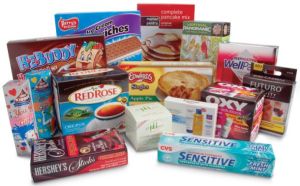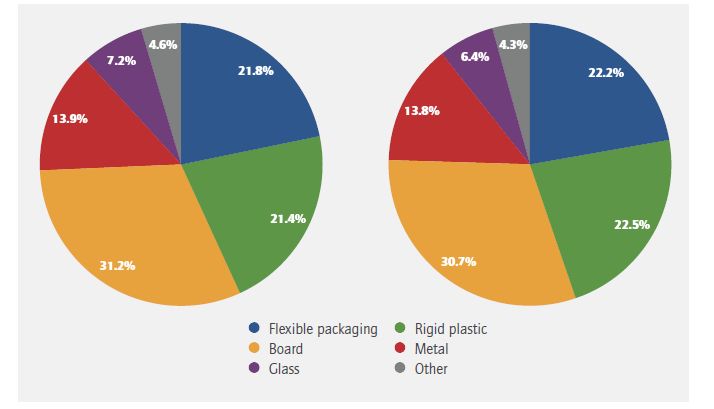
Rigid plastics, flexibles, and board, metal and glass packaging will drive industry expansion across the next five years.
In global researcher Smithers Pira's report, called The Future of Global Packaging to 2020, it states that the $839 billion packaging market will reach $998 million in value by 2020.
Rigid plastics will increase market share
Rigid plastic will experience the highest annual growth at 4.4% year-on-year, according to Smithers Pira.
This can primarily be attributed to the popularity of plastics such as polyethylene terephthalate (PET) as substitutes for heavier metal cans and glass bottles formats.
As a lightweight option these meet the dual goal of reduced material consumption and cost; and a reduced CO2 footprint during transit.
This transition is supported by consumers who perceive smaller or more lightweight packaging as being more environmentally friendly, though this does compete with a poor public perception of the environmental profile of plastics at end-of-life.
The push for environmental savings, cost optimisation and recyclability driven by technological developments – such as blow moulding and PET bottles for markets like UHT milk, and hot-fill bottles and jars for cooking sauces – is set to continue.
Coca-Cola is one major name looking to also address the negative connotations of packaging in plastic with the development of its 100 per cent bioplastic Plant Bottle 2.0. The soft drinks multinational plans to have complete a global switchover to these by 2020.

Growth of flexibles to slow down
Flexible format packaging – paper, plastics and foil laminates – expanded significantly over the past decade as technological changes have transformed the packaging type from a low-cost industrial-use option into consumer-grade containers with a vast variety of applications.
The market for flexibles – and particularly flexible plastics – will continue to boom over the next five years. This will happen at a rate slower than that witnessed in the first half of the decade, but will still exceed the mean market growth.
Smithers Pira’s data shows that Asia will continue to be the most significant regional market for flexible format packaging, and will increase its relative share of sales 42% to nearly 45% between 2015 and 2020.
Board packaging responds to online retailing
Board packaging (corrugated formats, folding cartons and liquid cartons) is the material type with the highest value in 2015 – $261 billion – a position it will retain in 2020. In 2015, China overtook the US as the largest national market for paperboard packaging and will account for nearly a quarter of global consumption in 2020.
The rise of online retail has been one consumer shift that is responsible for much of the recent growth in the board packaging market, an application where it is the dominant format. Emerging markets such as China and India shop online as frequently as more developed countries, and consumers increasingly prefer digital shopping over physical retail experiences.
This provides several key aspects of board packaging that are changing. For example 30-40 per cent of online purchases are returned, meaning that their packaging must be easily opened and resealed.
In the future, e-commerce will likely see even further focus on tailoring board packaging to maximise the end-user experience.
Stability in metal packaging
Metal packaging will mirror the average annual growth in packaging for 2015-2020 according to Smithers Pira’s data.
Demand will come from Asia, again spearheaded by China.
In the developed markets of Western Europe and North America, canned foods will suffer from competition from lighter weight, consumer friendly flexible and liquid paperboard materials. This is buttressed by health consciousness consumers in developed regions demonstrating a preference for fresh, rather than canned, fruit and vegetables.
Aerosol cans have seen an overall increase in demand as personal care, cosmetics, household and automotive care industries grow steadily.
This growth is primarily centred on the growing consumer class in Asia. There will be scope for innovation too, looking to repeat the success of the likes of Unilever that has cut its aluminium use by 24 tonnes per year after moving its deodorants to a 50 per cent smaller ‘compressed can’ format in 2013.
Glass considers a luxury future
The slowest growing packaging type for 2015-2020 is glass.
This reflects the longer-term transition of if from an essential commodity in packaging of beverages to a luxury material preferred to create a premium feel and sophisticated impression.
At the top-end of this market champagne houses are looking to pioneer isothemal packaging that keeps the product cold for around two hours after being removed from refrigeration.
Brewers meanwhile will continue to shift from traditional labels to premium-finish bottles using pressure-sensitive labels (PSL) to achieve a ‘no label’ look. At the same time they will investigate frosted glass, tactile effects and unique shapes to project a quality perception.





